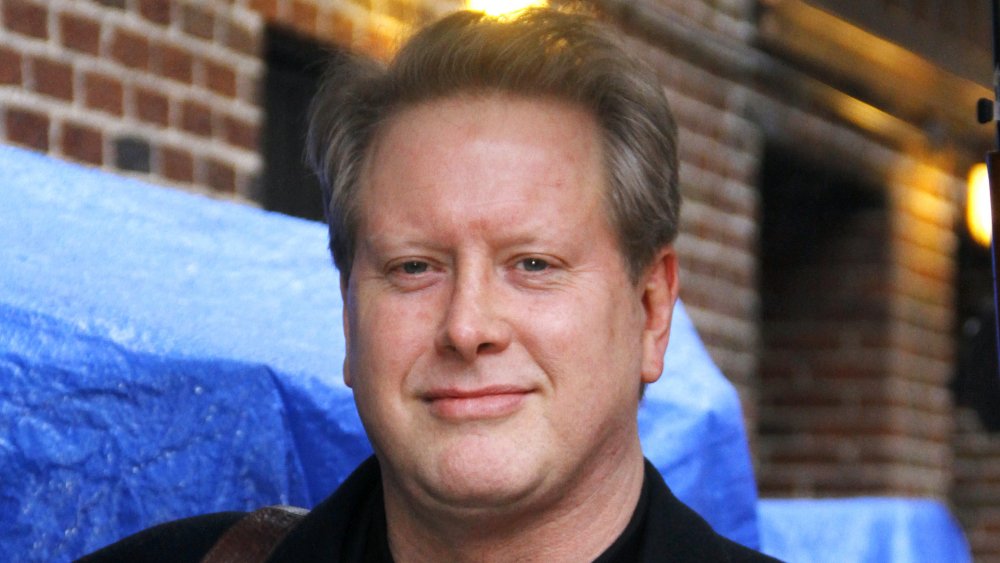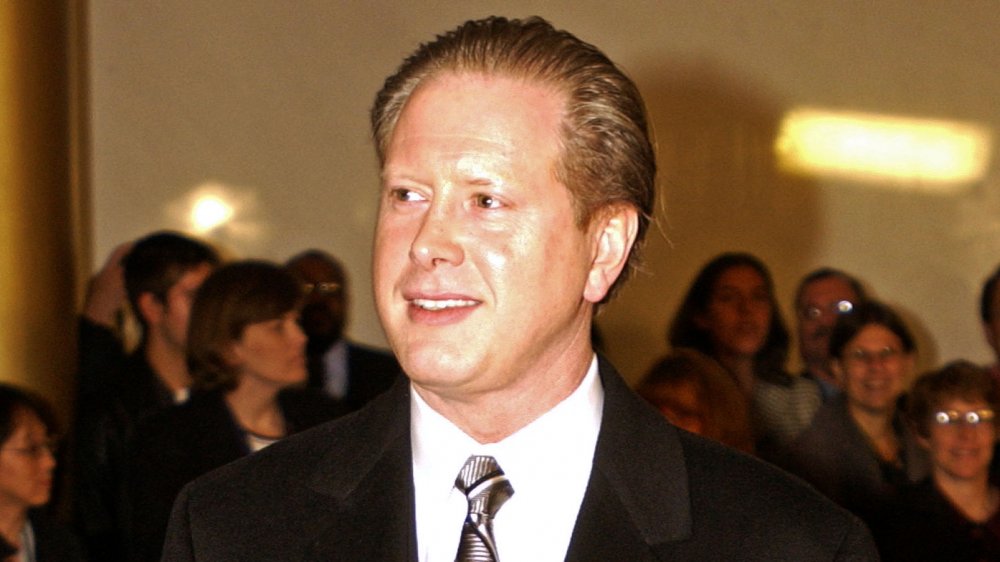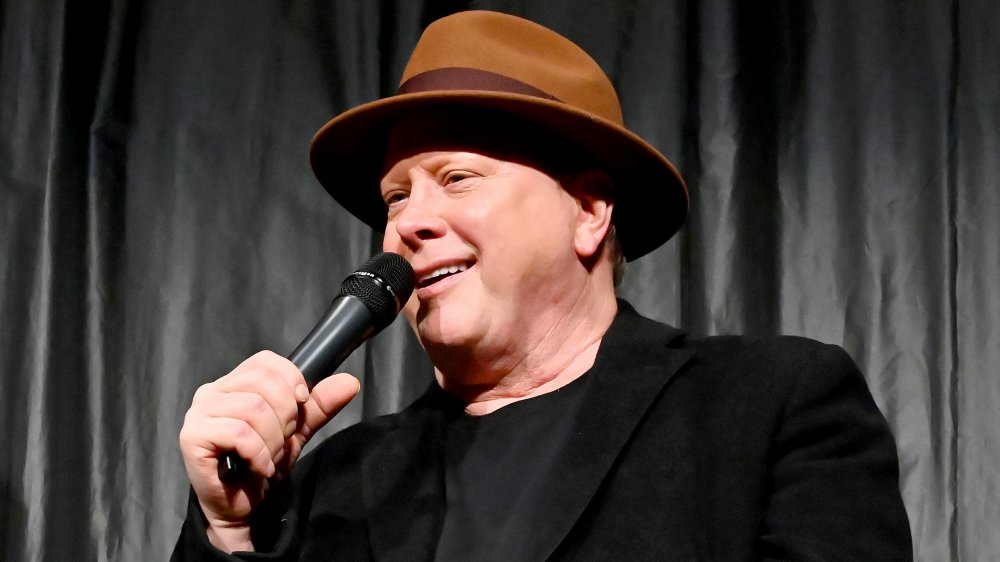The Tragic Real-Life Story Of Darrell Hammond
Drugs, alcohol, child abuse, destructive parents and self-harm are just several of the crippling obstacles Saturday Night Live star Darrell Hammond has survived over the course of his life. After decades of therapy, relapses, and hospitalizations, Hammond turned a corner in the 2010s, living a cleaner life and documenting his history of struggles in his 2011 memoir God, If You're Not Up There, I'm F*cked: Tales of Stand-Up, 'Saturday Night Live,' and Other Mind-Altering Mayhem, as well as the 2018 memoir documentary, Cracked Up.
Hammond, who took over as Saturday Night Live's on-air announcer in 2014 and continues to bring his renowned impressions to the SNL stage on occasion, had one of the longest tenures of any cast member, bringing to life the characters of Bill Clinton, Al Gore, Sean Connery, and Donald Trump, among many others. Beloved by viewers for his skills as an impressionist, Hammond battled many demons which he hid behind-the-scenes, only later making them public. Learn more about Hammond's long road to recovery after suffering a lifetime of pain.
If you or someone you know is having suicidal thoughts, please call the National Suicide Prevention Lifeline at 1-800-273-TALK (8255) or text HOME to the Crisis Text Line at 741741.
He suffered child abuse at the hands of his mother
In his 2011 memoir God, If You're Not Up There, I'm F*cked, Darrell Hammond revealed that he suffered terrible abuse from his mother, Margaret, which he further detailed in the 2018 documentary about his life, Cracked Up. "I was a victim of systematic and lengthy brutality," he told CNN in 2011. "My mom did some things which have cost me dearly." As he recalled in his memoir (via ABC News), "I am getting into the car to go somewhere with my mother. 'Wait,' she says, holding the door open. 'Put your hand there.' When I do, she slams the door."
Hammond told NPR's Fresh Air in 2011 that his mother tortured him with hammers, knives, and electrical outlets, and that he repressed the memories of his abuse for much of his life. "I remember the floor being red and me bleeding in a vague sense ... I thought it was my fault," he said. "I mean, can you imagine the desperation of a child who chooses to believe that he did this to himself just so he doesn't have to consider the idea that his mother did it or his parents did it?"
His father was an alcoholic World War II veteran
Darrell Hammond's father, Max, did not engage in the same kind of physical abuse as his mother. But as a World War II veteran, he was an alcoholic who suffered from "dreams of Nazis and dismembered corpses," Hammond told CNN in 2011, adding, "and it was frightening to be around that." In his 2011 Fresh Air interview, Hammond recalled that his father showed him a Nazi gun he took in combat and described killing a man to take it. "I was about 12, and he was sitting in the living room, just hammered on gin," he recalled. "He couldn't really function that well, except as a warrior."
Hammond also revisited his father's death in a 2019 podcast with the Mt. Sinai hospital network, joined by Michelle Esrick, the director of the 2018 Hammond documentary Cracked Up. "My father said on his deathbed, his last words, 'I let my anger be more important to me than my children,'" Hammond remembered. "'There was nothing as important to me. It was the only thing that was important to me.'" Esrick also asserted that Hammond's father may not have physically harmed Hammond, but he still left emotional scars, telling the podcast, "He was punching holes in Darrell's bedroom door when he was a little baby sleeping. What kind of effect would that have on your system? He was on the road. He wasn't attuned to what the mother was doing to Darrell."
Darrell Hammond was sexually abused by a housekeeper
Darrell Hammond revealed another aspect of his childhood trauma in the 2018 documentary Cracked Up: his family hired a housekeeper who eventually sexually abused him. "This is in the '50s, '60s," Hammond recounted in a 2019 podcast with the Mt. Sinai hospital network. "[We had] a housekeeper who did love me and who touched me every single day. And that's why they say I didn't turn out to be a criminal."
Also speaking on the podcast was Cracked Up director Michelle Esrick, who connected Hammond's memories of his sexual abuse with one interpretation of trauma offered in the documentary. "I remember when I interviewed Dr. Bessel Van der Kolk who's in the film, and I asked him what's the definition of trauma?" she revealed. "And I thought he was going to say, when you're hit this many times or when you're sexually abused this many times. And he said, when you are not seen or known, that is the trauma. That's it. When you're not seen or known."
He has been diagnosed as schizophrenic and bipolar
Darrell Hammond was diagnosed with an array of mental disorders, including bipolar disorder, manic depression, and schizophrenia. "I've been in treatment since I was 19, and I'm 56. So that's a couple of bucks and a long time," he told NPR's Fresh Air while also recounting to CNN that his medications were "soul-killing," though they eventually saved his life. "I was on as many as seven medications at one time," he said. "Doctors didn't know what to do with me."
Hammond said he suffered from misdiagnoses for years, until he came under the care of Dr. Nabil Kotbi at the psychiatric facility The Plains in 2010, crediting the doctor for helping him realize the psychological roots of his mental health issues. "You are this way because of something that happened to you," Hammond remembers Kotbi telling him in the 2018 documentary Cracked Up (via CNN). Kotbi's therapy helped Hammond grasp the extent of his childhood trauma and understand the way it impacted his brain. "People were approaching me as if mental illness was an airborne virus, as if this had come from nowhere and a bunch of drugs would fix it," Hammond told The Columbus Dispatch. "That's the way it went for a long time."
Darrell Hammond engaged in self-harm for decades
Darrell Hammond self-harmed for decades, and he often engaged in the acts backstage at Saturday Night Live. "[I] was a lifetime cutter," he recounted in his 2019 podcast interview with the Mt. Sinai hospital network. "I started actually cutting when I was 19 and I cut until about the age of 50, I'm gonna say 53 maybe?"
Hammond recalled in the Cracked Up documentary that he started cutting when he began having flashbacks to his childhood trauma, which he often visualized as the color red, and he would self-harm as a way to soothe his mind. "There is a floating red ball of light," he says in the documentary (via CNN). "This odd image produced a terror in me. And the terror would only stop if I cut my wrists." Additionally, his drinking compounded his tendencies towards self-harm, the comedian wrote in his memoir. "I kept a pint of Remy in my desk at work," Hammond said about his Saturday Night Live days (via The Hollywood Reporter). "The drinking calmed my nerves and quieted the disturbing images that sprang into my head ... when drinking didn't work, I cut myself."
He battled a cocaine addiction
Darrell Hammond wrote in his 2011 memoir God, If You're Not Up There, I'm F*cked that he abused cocaine and crack, initially getting hooked in 2002. "I'd started adding an obscene amount of cocaine to my binges," he wrote (via Page Six). "I had to be creative about how I did it without other people catching on or letting it interfere with the work. At least too much."
During his final season on Saturday Night Live in 2009, Hammond "had the brilliant idea [he] should try crack," he wrote, adding that he spent time in a Harlem crack house. In 2018, he recounted his crack experimentation to Daily Beast, adding that a topless woman recognized him from one of his most famous Saturday Night Live impressions. "That's Clinton!" Hammond recalled her saying. "I was like, really? A breath away from hell."
Despite his drug use, Hammond has made sure to claim that he never appeared on SNL drunk. "I never drank on game day. I always showed up pretty solid," he said, although also quipped, "There was one morning I drank at 8 a.m. But that was just once."
He was once taken from SNL in a straightjacket
Darrell Hammond suffered years of debilitating PTSD as a result of his childhood traumas, and his flashbacks affected him during his Saturday Night Live appearances, including a famous episode where he played Al Gore debating Will Ferrell's George W. Bush character. "I was disoriented and frightened, and I was feeling every single thing that happened to me when I was in the kitchen once with my mother," he told Fresh Air in 2011. Speaking with CNN that same year, Hammond recalled, "There was cutting backstage. In fact, the week that I did the Gore debates, I believe I was taken away in a straitjacket."
Transported to a New York psychiatric hospital, Hammond described in his memoir (via The Hollywood Reporter) that, when his wife came to visit him, "[he] didn't recognize her." Looking back on his struggles on-set at SNL, Hammond told Fresh Air that the show's "power brokers" knew about his struggles, and he was thankful they allowed him to stay on the show. "It was a delicate balance for them and not one that they deserved to have to go through," he recalled, adding, "but I thought they were very brave about it."
He struggled to impersonate John McCain
Darrell Hammond may have been Saturday Night Live's master impressionist for the years he was on the show, but he struggled to play John McCain because of the late senator's experiences with torture as a prisoner in the Vietnam War, as well as his father's own life as a veteran "haunted" by memories of World War II. "I didn't want to make fun of a guy whose body, soul, and voice were changed by combat," Hammond told CNN in 2011. "This is why I had a hard time playing John McCain and didn't want to play John McCain."
The comedian said that his father, who was "on his deathbed" at the time that Hammond was approached to play McCain, encouraged him to take the part, oblivious of the childhood traumas that playing the McCain character triggered in his son. "I don't think that he was aware," Hammond said about his mother's abuse, which also complicated his portrayal of McCain, as he related to the politician's torture. The SNL star further explained his reasoning to Fresh Air in 2011, adding that he didn't want to mock a prisoner of war. "If you're injured, it changes the way you move," Hammond said of McCain. "If you're injured, it changes the way you talk. I didn't want to lampoon someone, you know, who had given his life."
Darrell Hammond tried to cut off his own arm
Darrell Hammond's 2011 memoir, God, If You're Not Up There, I'm F*cked, reveals that the actor landed in a mental facility a year before his book was published — and for extremely disturbing reasons that involved what the comedian calls a "vat" of absinthe (via The Daily Beast). "I was sent to the Sanctuary, a few miles north of New York City, via ambulance in the fall of 2010 after getting drunk and trying to cut off my arm with a large kitchen knife," he wrote in his book.
Hammond also described how he entered psychiatric facilities under false names, only to have fellow patients recognize him and ask him to reprise his Saturday Night Live impressions. "I wasn't in the mood to be recognized while I got myself sorted out, so I checked in under a false name," he wrote. "Unlike certain celebrities who like to share their meltdowns with Matt Lauer or TMZ, I prefer to bring the heavens crashing down around me in private." Fair enough.
He had a fraught adult relationship with his mother
After repressing memories of his mother's abuse well into his adult years, Darrell Hammond detailed in Cracked Up, the 2018 documentary about his life, how his mother tried to re-insert herself in his life. Following the birth of his daughter Mia in 1998 with his then-wife Elizabeth, Hammond said that his mother called and offered to watch his daughter, triggering his protective instincts. "My wife got pregnant," Hammond said in the film (via CNN). "The baby was born, and then I heard my wife say, your mom called, and she said, 'Hey, as a mommy, you all need some breaks,' so she said she would take the baby. My soul knew all along what had happened. And I didn't know until my child's life was now on the line."
After undergoing therapy, Hammond eventually called his mother and confronted her about his traumatic upbringing — yet she turned him away. As he told Fresh Air in 2011, "I called her on the phone and I said, 'I'm being treated for symptoms [similar to] prisoners of war ... but all I did was grow up in your house. Can you talk to me about that?'" He remembers his mother answering in a menacing tone, "Don't ever call us again," before hanging up on him, with the two losing contact until shortly before her death.
Losing the SNL Donald Trump role deeply affected him
While Darrell Hammond had left the Saturday Night Live cast years before Donald Trump became POTUS, the show brought him back as a featured player to impersonate Trump starting in late 2015. After all, Hammond had been playing Trump for over a decade on SNL, with his first appearance as the character dating all the way back to 1999, and took over as SNL's on-air announcer in 2014.
Speaking to The Washington Post in 2017, Hammond said that he moved back to New York in 2016, planning on assuming a larger role on the show. Unfortunately, SNL had other plans, with Hammond finding out in September 2016 that instead of him, Alec Baldwin would be SNL's go-to Trump actor. "I just started crying," he told the outlet about receiving the news. "In front of everyone. I couldn't believe it. I was in shock, and I stayed in shock for a long time."
Hammond later found out that his impersonation had Trump's seal of approval, with the president tweeting in March 2018 that Hammond was "funnier and a far greater talent" than Baldwin. "I couldn't believe it," Hammond told The Hollywood Reporter about Trump's tweet, while emphasizing that he holds no ill will towards Baldwin. "The truth is, I have known Alec for a long time and always enjoyed his company."












